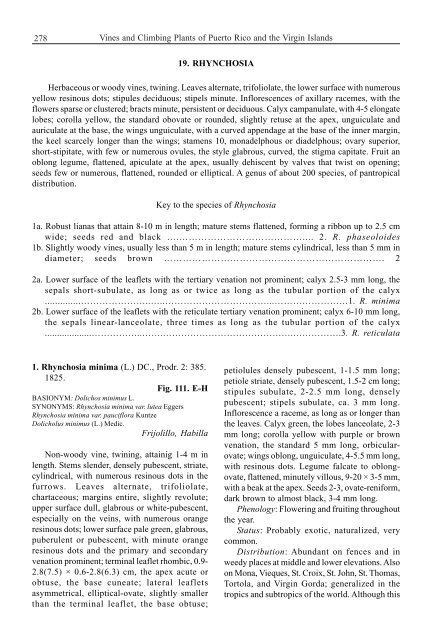Vines and Climbing Plants of Puerto Rico and the Virgin Islands
Vines and Climbing Plants of Puerto Rico and the Virgin Islands
Vines and Climbing Plants of Puerto Rico and the Virgin Islands
You also want an ePaper? Increase the reach of your titles
YUMPU automatically turns print PDFs into web optimized ePapers that Google loves.
278<br />
<strong>Vines</strong> <strong>and</strong> <strong>Climbing</strong> <strong>Plants</strong> <strong>of</strong> <strong>Puerto</strong> <strong>Rico</strong> <strong>and</strong> <strong>the</strong> <strong>Virgin</strong> Isl<strong>and</strong>s<br />
19. RHYNCHOSIA<br />
Herbaceous or woody vines, twining. Leaves alternate, trifoliolate, <strong>the</strong> lower surface with numerous<br />
yellow resinous dots; stipules deciduous; stipels minute. Inflorescences <strong>of</strong> axillary racemes, with <strong>the</strong><br />
flowers sparse or clustered; bracts minute, persistent or deciduous. Calyx campanulate, with 4-5 elongate<br />
lobes; corolla yellow, <strong>the</strong> st<strong>and</strong>ard obovate or rounded, slightly retuse at <strong>the</strong> apex, unguiculate <strong>and</strong><br />
auriculate at <strong>the</strong> base, <strong>the</strong> wings unguiculate, with a curved appendage at <strong>the</strong> base <strong>of</strong> <strong>the</strong> inner margin,<br />
<strong>the</strong> keel scarcely longer than <strong>the</strong> wings; stamens 10, monadelphous or diadelphous; ovary superior,<br />
short-stipitate, with few or numerous ovules, <strong>the</strong> style glabrous, curved, <strong>the</strong> stigma capitate. Fruit an<br />
oblong legume, flattened, apiculate at <strong>the</strong> apex, usually dehiscent by valves that twist on opening;<br />
seeds few or numerous, flattened, rounded or elliptical. A genus <strong>of</strong> about 200 species, <strong>of</strong> pantropical<br />
distribution.<br />
Key to <strong>the</strong> species <strong>of</strong> Rhynchosia<br />
1a. Robust lianas that attain 8-10 m in length; mature stems flattened, forming a ribbon up to 2.5 cm<br />
wide; seeds red <strong>and</strong> black ….………………………………….... 2. R. phaseoloides<br />
1b. Slightly woody vines, usually less than 5 m in length; mature stems cylindrical, less than 5 mm in<br />
diameter; seeds brown ……………………………………………………………. 2<br />
2a. Lower surface <strong>of</strong> <strong>the</strong> leaflets with <strong>the</strong> tertiary venation not prominent; calyx 2.5-3 mm long, <strong>the</strong><br />
sepals short-subulate, as long as or twice as long as <strong>the</strong> tubular portion <strong>of</strong> <strong>the</strong> calyx<br />
..............…………………..…..……………………………...……………………1. R. minima<br />
2b. Lower surface <strong>of</strong> <strong>the</strong> leaflets with <strong>the</strong> reticulate tertiary venation prominent; calyx 6-10 mm long,<br />
<strong>the</strong> sepals linear-lanceolate, three times as long as <strong>the</strong> tubular portion <strong>of</strong> <strong>the</strong> calyx<br />
...................……………..…….…………………………………….…………….3. R. reticulata<br />
1. Rhynchosia minima (L.) DC., Prodr. 2: 385.<br />
1825.<br />
Fig. 111. E-H<br />
BASIONYM: Dolichos minimus L.<br />
SYNONYMS: Rhynchosia minima var. lutea Eggers<br />
Rhynchosia minima var. pauciflora Kuntze<br />
Dolicholus minimus (L.) Medic.<br />
Frijolillo, Habilla<br />
Non-woody vine, twining, attainig 1-4 m in<br />
length. Stems slender, densely pubescent, striate,<br />
cylindrical, with numerous resinous dots in <strong>the</strong><br />
furrows. Leaves alternate, trifoliolate,<br />
chartaceous; margins entire, slightly revolute;<br />
upper surface dull, glabrous or white-pubescent,<br />
especially on <strong>the</strong> veins, with numerous orange<br />
resinous dots; lower surface pale green, glabrous,<br />
puberulent or pubescent, with minute orange<br />
resinous dots <strong>and</strong> <strong>the</strong> primary <strong>and</strong> secondary<br />
venation prominent; terminal leaflet rhombic, 0.9-<br />
2.8(7.5) × 0.6-2.8(6.3) cm, <strong>the</strong> apex acute or<br />
obtuse, <strong>the</strong> base cuneate; lateral leaflets<br />
asymmetrical, elliptical-ovate, slightly smaller<br />
than <strong>the</strong> terminal leaflet, <strong>the</strong> base obtuse;<br />
petiolules densely pubescent, 1-1.5 mm long;<br />
petiole striate, densely pubescent, 1.5-2 cm long;<br />
stipules subulate, 2-2.5 mm long, densely<br />
pubescent; stipels subulate, ca. 3 mm long.<br />
Inflorescence a raceme, as long as or longer than<br />
<strong>the</strong> leaves. Calyx green, <strong>the</strong> lobes lanceolate, 2-3<br />
mm long; corolla yellow with purple or brown<br />
venation, <strong>the</strong> st<strong>and</strong>ard 5 mm long, orbicularovate;<br />
wings oblong, unguiculate, 4-5.5 mm long,<br />
with resinous dots. Legume falcate to oblongovate,<br />
flattened, minutely villous, 9-20 × 3-5 mm,<br />
with a beak at <strong>the</strong> apex. Seeds 2-3, ovate-reniform,<br />
dark brown to almost black, 3-4 mm long.<br />
Phenology: Flowering <strong>and</strong> fruiting throughout<br />
<strong>the</strong> year.<br />
Status: Probably exotic, naturalized, very<br />
common.<br />
Distribution: Abundant on fences <strong>and</strong> in<br />
weedy places at middle <strong>and</strong> lower elevations. Also<br />
on Mona, Vieques, St. Croix, St. John, St. Thomas,<br />
Tortola, <strong>and</strong> <strong>Virgin</strong> Gorda; generalized in <strong>the</strong><br />
tropics <strong>and</strong> subtropics <strong>of</strong> <strong>the</strong> world. Although this
















